Having sculpted a quietly atmospheric, lyrically autumnal installation as his entry for the 2011 Turner prize, Martin Boyce was presented with the US$40,000 award on Monday night at a ceremony at the Baltic Centre for Contemporary Art in Gateshead, northern England.
Boyce, 44, is the third successive Turner winner either brought up or educated in Glasgow, following Susan Philipsz last year and Richard Wright in 2009, and he confirms the city’s now indelible importance to Britain’s art world.
The artist was born in Hamilton, and was among the first students to graduate from Glasgow School of Art’s now famous environmental art course. His year included Douglas Gordon, who won the prize in 1996, and Nathan Coley, short-listed in 2007.
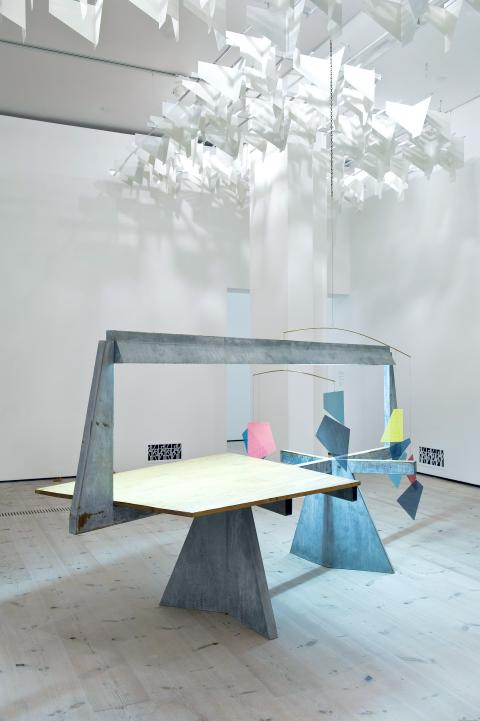
Photo: Reuters
The prize was handed to Boyce by photographer Mario Testino at the Gateshead gallery. It is the first time the Turner prize has been shown outside the Tate family of galleries, and only the second time outside London.
Boyce created an installation for the Turner that has the feel both of an interior space and a mournful municipal park. Trees (in fact, the pillars that support the gallery ceiling) loom, their geometric aluminum leaves dappling the light that is cast over the space. On the ground are scattered more leaves, this time cut from paper, each of them of the same rebarbative, angular shape.
There is a madly angular park bin, too. But there is also a desk, based on a library table by French modernist designer Jean Prouve, with letters scratched into it as if by a schoolchild. Much of the artistic vocabulary for Boyce’s installation derives from a modernist garden — complete with concrete trees — created by designers Joel and Jan Martel in Paris in 1925.
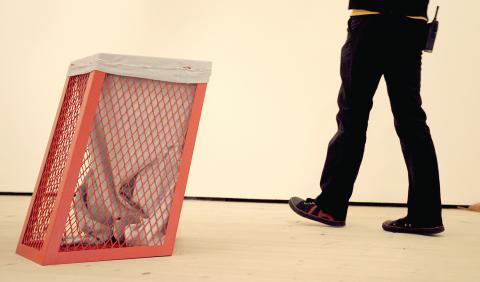
Photo: Reuters
The judges praised his “opening up of a new sense of poetry,” while Nicholas Serota, director of Tate, not a member of the jury, commented: “He is an extraordinarily strong artist who has been steadily maturing over the past seven or eight years. He made an extremely strong show for the Venice Biennale in 2009 — and I am surprised he was not short-listed then. It is a strong choice.
“He has consistently reinvented the language of early modern art, and he is deeply engaged in that. But he makes work that does not depend on an understanding of early modern art: it is beautiful and arresting in its own right.”
Boyce was the bookies’ favorite for the prize, but many will be disappointed that George Shaw, 44, missed out.
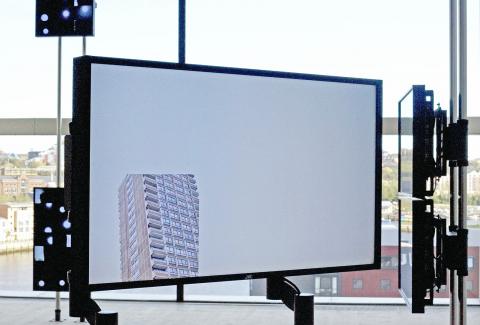
Photo: AFP
Shaw, who is based in Devon, southwest England, paints the housing estate where he grew up near Coventry, skirting dangerously close to kitsch with his deadpan, affectless depictions of dreary side roads, locked-up shops, littered half-urban woods and derelict pubs — the depressing but utterly recognizable edge lands of suburban England.
He had been nominated for a solo exhibition at the Baltic earlier this year.
Karla Black, 38, is another short-listed artist who was educated at the Glasgow School of Art and is still based in the city. Nominated for an exhibition at this year’s Venice Biennale representing Scotland, her sculptures for the Turner show are simultaneously delicate and on a huge scale. Here are giant, rolled-up balls of sugar paper chalked over in ice-cream colors, “bath bombs” from a high-street toiletries chain and painted polyethylene sheets made to dangle from the ceiling by sticky tape.
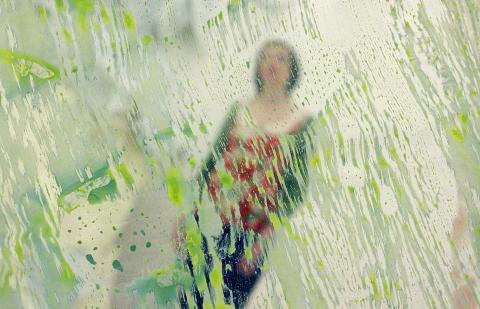
Photo: AFP
The final short-listed artist was Hilary Lloyd, 46, based in London. Working with video, she creates works that are part film and part sculpture, reveling in the physical apparatus of her hardware’s cabling and projectors, and showing images — of say a road bridge, a shadow on the floor, or the moon — that are deliberately unedited. She was nominated for an exhibition at the London gallery Raven Row. Judges for the 2011 Turner prize were Godfrey Worsdale, director of Baltic, and curators Katrina Brown, Vasif Kortun and Nadia Schneider. They were chaired by the director of Tate Britain, Penelope Curtis.
The prize returns to London and Tate Britain next year. It will be based in Derry in 2013, with the intention it should travel to cities outside London in alternate years.
The Turner prize was founded in 1984 and is awarded to a British or Britain-based artist aged under 50 for an outstanding exhibition in the preceding year.
Previous winners include Rachel Whiteread (1994), Damien Hirst (1995) and Grayson Perry (2003). The Turner exhibition continues until 8 Jan, 2012.

When the South Vietnamese capital of Saigon fell to the North Vietnamese forces 50 years ago this week, it prompted a mass exodus of some 2 million people — hundreds of thousands fleeing perilously on small boats across open water to escape the communist regime. Many ultimately settled in Southern California’s Orange County in an area now known as “Little Saigon,” not far from Marine Corps Base Camp Pendleton, where the first refugees were airlifted upon reaching the US. The diaspora now also has significant populations in Virginia, Texas and Washington state, as well as in countries including France and Australia.

On April 17, Chinese Nationalist Party (KMT) Chairman Eric Chu (朱立倫) launched a bold campaign to revive and revitalize the KMT base by calling for an impromptu rally at the Taipei prosecutor’s offices to protest recent arrests of KMT recall campaigners over allegations of forgery and fraud involving signatures of dead voters. The protest had no time to apply for permits and was illegal, but that played into the sense of opposition grievance at alleged weaponization of the judiciary by the Democratic Progressive Party (DPP) to “annihilate” the opposition parties. Blamed for faltering recall campaigns and faced with a KMT chair

Article 2 of the Additional Articles of the Constitution of the Republic of China (中華民國憲法增修條文) stipulates that upon a vote of no confidence in the premier, the president can dissolve the legislature within 10 days. If the legislature is dissolved, a new legislative election must be held within 60 days, and the legislators’ terms will then be reckoned from that election. Two weeks ago Taipei Mayor Chiang Wan-an (蔣萬安) of the Chinese Nationalist Party (KMT) proposed that the legislature hold a vote of no confidence in the premier and dare the president to dissolve the legislature. The legislature is currently controlled
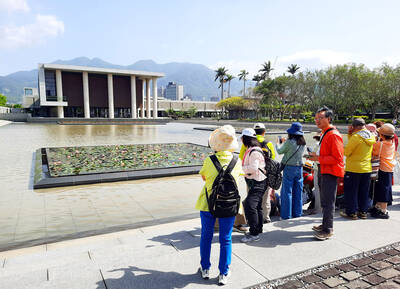
Dull functional structures dominate Taiwan’s cityscapes. But that’s slowly changing, thanks to talented architects and patrons with deep pockets. Since the start of the 21st century, the country has gained several alluring landmark buildings, including the two described below. NUNG CHAN MONASTERY Dharma Drum Mountain (法鼓山, DDM) is one of Taiwan’s most prominent religious organizations. Under the leadership of Buddhist Master Sheng Yen (聖嚴), who died in 2009, it developed into an international Buddhist foundation active in the spiritual, cultural and educational spheres. Since 2005, DDM’s principal base has been its sprawling hillside complex in New Taipei City’s Jinshan District (金山). But